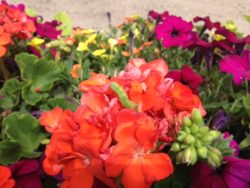Hot weather tips:
- When temperatures are over 90 degrees, check flowers twice daily for water, in the morning and again in the evening. Some pots/beds may require additional water applications to fight the heat.
- Don’t get caught over-watering when temps cool down again.
- Keep up with your regular fertilizer regime.
- Flowers that may be struggling in the heat should be moved to a protected location to take off the stress. When it cools down, move them back to original location.
- Where a plant has failed, consider filling the hole with a splash of color. Creek Side has a great selection that will work perfectly!
Get a second bloom from tired annuals by cutting them back now with a sharp pair of garden shears and then fertilizing with Jack’s Blossom Booster. Fresh flowers will arrive in a couple of weeks.
In the perennial bed, deadhead the spent flowers and evaluate general plant health. Cut some unspent flowers for a fresh table arrangement to enjoy in the house or patio!
Perennials can still be planted now particularly on a cloudy day or early or late in the day. Mulch any areas of bare soil to help hold in moisture and keep temperatures cooler.
Fertilize roses monthly.
Weed control – Be proactive about pulling and preventing weeds from flowering as they can compete with other plants for space, nutrients, water, and light.
Increase fullness of plants– Pinch back chrysanthemums to encourage bushier growth, just by nipping off the last half inch of the stem with your thumb and index finger.
Apply mulch to the vegetable garden soil. Grass clippings that have not been treated with an herbicide work well when distributed thinly over the soil.
Apply water to lawns early in the day before 9:00am. This will reduce evaporation and allow the foliage to dry off before nightfall to help avoid diseases. Wait to fertilize cool-season grasses like Kentucky bluegrass until later this summer when temperatures begin cooling down.
Budworms are showing up!
 Now is the time to treat for Budworm. The adult stage is a moth with a wingspan of about 1 1/2 inches. The wings are light green with brown overtones and a few wavy, cream-colored bands. In the early evening, females lay single eggs on buds or leaves. The eggs hatch into little light green worms. They have two cycles per summer – early July and early August. Budworms prefer to feed on petunia, geranium and verbena plants. They feed on the flower buds of these species. You might notice that there are less and less flowers, flowers that looked chewed upon, or little black worm droppings in the leaves.
Now is the time to treat for Budworm. The adult stage is a moth with a wingspan of about 1 1/2 inches. The wings are light green with brown overtones and a few wavy, cream-colored bands. In the early evening, females lay single eggs on buds or leaves. The eggs hatch into little light green worms. They have two cycles per summer – early July and early August. Budworms prefer to feed on petunia, geranium and verbena plants. They feed on the flower buds of these species. You might notice that there are less and less flowers, flowers that looked chewed upon, or little black worm droppings in the leaves.
Treat now and treat again in late July to help keep these flowers in full bloom all summer long. Consider using:
- Natural Guard RTU Caterpiller killer w/ Bt, the biological Bacillus thurengiensis – organic choice
- Fertilome Dipel Dust w/ Bt – organic choice
- Bonide RTU Captain Jack’s Deadbug w/ biological Spinosad – organic choice
- Natural Guard Spinosad Soap – soap w/ biological Spinosad – RTU for small applications or hose end RTS for large applications – organic choice
- Bonide Eight RTU for small applications or the hose end RTS for large applications
*Please read and follow all directions provided by manufacturer of each product your try*

